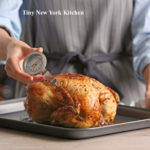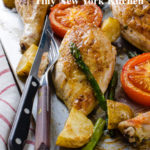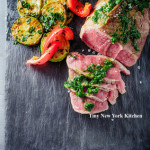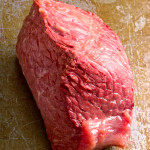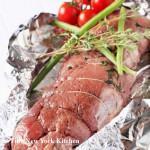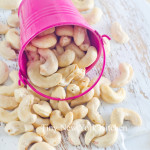When cooking meats, it’s important to know the various temperatures.
Beef: Rare 120F to 125F (45C to 50C), Medium Rare 130F to 135F (55C t 60C), Medium 140F to 145F (60C to 65C), Medium-Well 150F to 155F (65C to 70C), Well Done 160F and above (70C and above)
Pork: Medium Rare 145F (63C), Medium 160F (70C), Well Done 170F (76C)
Poultry: Well Done 165F (75C)
Lamb: Medium Rare 145F (65C), Medium 160F (70C), Well Done 170F (76C)
Fish: Well Done 145F (65C)
To find out what temperature your meat is at, remove food from oven, turn on the digital display by pressing the on/off button. Select F/C. Insert thermometer in the thickest part of the meat, immersing the stem at least 1 inch, but not to contact with bone, fat or gristle and wait for the temperature to stabilize.
The digital display will automatically give you the cooking temperature. If additional cooking time is needed, remove the thermometer from the food and return the dish to the oven.
“Work With What You Got!”
©Tiny New York Kitchen © 2021 All Rights Reserved
Roasting refers to proteins and vegetables cooked mostly at high temperatures in the oven. Baking uses a lower temperature to cook breads, baked goods, and casseroles.
Roasting makes any vegetable taste better. It brings out their flavor, caramelizes their natural sugars, and adds crunch. If your family doesn’t love certain vegetables like broccoli or Brussels sprouts, roasting is a great way to change their mind. Double what you’re roasting and then turn extra servings into quick meals later in the week. Cooking a little extra with one meal lets you make the most of value-sized packages of proteins and other store sales. With leftover already planned, you won’t need to lean on takeout.
Why we love to roast:
It’s Affordable! Inexpensive ingredients are tastiest when roasted. Root vegetables are browned and crisp, tomatoes and grapes are extra juicy and sweet, and tough cuts of beef are fall-apart tender. You also don’t need any special equipment to roast.
Roasting Is Healthful! Roasted foods need very little fat to cook compared to frying or sautéing. Roasting also intensifies flavors without added salt, sugar, or other ingredients.
It’s Easy! Roasted foods need little prep before they cook. And once the oven door closes, you can walk away. Fewer pans and utensils are needed, making cleanup easier too.
Essential Tools For Roasting:
Rimmed Sheet Pan: The rim keeps vegetables from falling off the sides and catches any juices from meats and fish.
Oven-Save Skillet: Go from stovetop to oven and back. Sear meats before roasting or make a pan sauce with the meat drippings after roasting.
Roasting Pan: Best for large roasts, hams, and turkeys. An inner rack lifts the meat so it can brown and crisp underneath.
Parchment Paper: Line pans to keep foods from burning and sticking, then toss for easy cleanup. If roasting at a higher temp or broiling use foil.
Metal Tongs: Flip and stir foods on a hot pan with ease. Look for tongs with a heat resistant grip.
Silicone Brush: Brush on a sticky glaze or baste foods with sauce. The silicone bristles are easy to clean.
Tips For Sheet Pan Roasting:
Jump Start Browning by preheating your sheet pan before adding vegetables.
Pat foods very dry with paper towels so the outside browns while the inside cooks through.
Cut foods to the same size and thickness so smaller pieces don’t burn.
Space out foods on the sheet pan so they have room to crisp and brown.
Let sheet pans cool before rinsing to keep the metal from warping.
©Tiny New York Kitchen © 2021 All Rights Reserved
Eating well just got easier. Use one or more ingredients from each of the five categories. Stick with one international flavor profile. Find a sauce in your market’s global-foods section: ssamjang, chutney, hot sauce, salsa, pesto, chimichurri, romesco, aioli, tahini, or peanut sauce. Save money by using leftovers. Save time by using prechopped fresh vegetables.
CHOOSE A BASE INGREDIENT
1/2 Cup
Cooked Brown Rice, Quinoa, Millet, Bulgur, Farro, Barley, Whole Grain Pasta
CHOOSE A LEAN PROTEIN
3 To 4 Ounces
Cooked Meat, Poultry, Seafood, Legumes, Eggs, Tofu
CHOOSE VEGETABLES
1 To 2 Cups
Vary Colors And Textures
CHOOSE A SAUCE
1 To 3 Tablespoons
Sriracha, Harissa, Soy, Sweet Chili, Ssamjang, Chutney, Hot Sauce, Salsa, Pesto, Chimichurri, Romesco, Aioli, Tahini, Peanut Sauce
Bowl Ideas
Korean: Cooked noodles or rice, shredded carrot, sliced cucumber, sliced daikon radish, bean sprouts, sliced grilled beef, runny fried egg, ssamjang, kimchi
Middle Eastern: Cooked bulgur, roasted eggplant, roasted cauliflower, sautéed spinach, cooked chickpeas, grilled chicken, minted yogurt sauce, roasted pumpkin seeds, za’atar spice blend
Italian: Cooked faro, sautéed zucchini, sautéed kale, roasted red peppers, roasted cherry tomatoes, tuna, pesto, olives, marinated artichoke hearts, pine nuts
“Work With What You Got!”
©Tiny New York Kitchen © 2019 All Rights Reserved
We at Tiny New York Kitchen get it! Especially during the holidays you don’t want to ruin a good piece of meat. Here are some general guidelines for producing the best results for your holiday meal.
Remove meat from the refrigerator at least an hour before roasting so it can come closer to room temperature.
Start the roast at 450 degrees for 15 minutes to develop a nice crust.
Drop the oven to 350 degrees for an additional 15 to 20 minutes per pound.
Remember, you must cook to temperature, NOT time, because every oven and piece of meat is unique. So, take the temperature of the roast every 20 to 30 minutes to avoid overcooking. 120 degrees (50C) for rare and 130 degrees (55C) for medium-rare.
Always use a meat thermometer. An instant-read probe thermometer helps dispel any guesswork.
Remove from oven and loosely cover roast with foil to keep warm and rest it for 30 minutes. Don’t be alarmed when you see the temperature of the roast creep upwards a few degrees while it rests. This is perfectly normal and expected.
These directions will work for nearly all holiday roasts. The exceptions are thinner/smaller roasts like beef tenderloin or rack of lamb. These can be cooked at 400 degrees for the entire time, using a meat thermometer to monitor progress.
“Work With What You Got!”
©Tiny New York Kitchen © 2018 All Rights Reserved
It’s that time of year again, in America, when the beer turns green and the aroma of corned beef and cabbage fills the air. The dish is so comforting, but just what is corned beef? The term has nothing to do with corn, but was the English term for a small granule, such as a grain of salt. In days before modern refrigeration, salting meat was a way to preserve it and keep it from spoiling.
Corned beef is an Americanized addition to the traditional Irish diet. While colcannon (boiled potatoes, cabbage, and leeks in buttermilk flavored with wild garlic) was a common Irish dish, as was brown soda bread, corned beef was produced primarily for export to England. Upon arriving in America, however, it’s thought the Irish chose to celebrate their holiday with food that was typically not available to them in their home country, so corned beef was added to the menu, as was white soda bread studded with currants and caraway.
Corned beef is typically made from beef brisket, which is a cut of meat from the breast or lower chest, but the rump, bottom round, and even tongue, can be used. In America, the term “corned beef” is used to describe both the cured meat and the canned stuff found on grocery store shelves. In Britain, they call the canned stuff “salt beef.”
To make corned beef the meat is simmered in a blend of corned beef spices that usually include peppercorns, garlic, mustard, tarragon, thyme, parsley, cloves, and nutmeg.
In New England, you most often see corned beef served as a St. Patrick’s Day main dish or in a sandwich. As the main ingredient in New England Boiled Dinner, corned beef often pairs with potatoes, carrots, turnips, and cabbage in a hearty, savory, brothy bowl of goodness. When used in a sandwich, the most popular corned beef sandwich is the Reuben. Considered the quintessential Jewish deli sandwich, a Reuben is toasted rye bread stuffed with hot slices of corned beef, usually piled high, and topped with sauerkraut, Swiss cheese, and either Russian or Thousand Island dressing.
In New England, a frequent point of interest is also whether you prefer red vs. gray corned beef. The difference is “Red” brisket is cured with nitrite, which gives the meat its signature color. “Gray” corned beef, which is considered the authentic New England variety, is not cured with nitrate, so color forms naturally as it brines.
If you have corned beef leftovers a New England favorite is corned beef hash, which is typically served for breakfast.
“Work With What You Got!”
©Tiny New York Kitchen © 2018 All Rights Reserved
Standing Beef Rib Roast
How Much To Buy: A 54 to 5 Pound Roast Serves 8 to 10
Keep meat at room temperature for an hour or so. Preheat oven to 450 degrees. Rub roast with lots of olive oil, cracked peppercorns, minced garlic, kosher salt, and 2 tablespoons of an herb or spice rub, if desired. Place roast meat-side down in a roasting pan and cook 30 minutes. Reduce heat to 425 degrees. Continue roasting for about 3 minutes per pound. Turn oven back up to 450 degrees and roast another 15 minutes, or until meat thermometer reaches 125 degrees for rare, 140 degrees for medium-rare or 160 degrees for well-done. Remove from oven and let rest 15 minutes. Skin fat from juices, and pour some dry red wine into the pan with the drippings. Over a low heat, stir wine, scraping up any browned bits on bottom of pan. Serve over roast as a sauce.
Roasted Beef Tenderloin
How Much To Buy: A 4 to 5 Pound Tenderloin Serves 8
Position oven rack in center. Preheat oven to 425 degrees. Lightly oil a roasting pan. Mix 2 tablespoons olive oil, 1 tablespoon minced garlic, 2 teaspoons each of rosemary and thyme, and kosher salt and freshly ground pepper to taste. Rub over entire surface of meat. Place meat into roasting pan and cook until thermometer inserted into thickest part of the roast reads 125 degrees for rare, 140 degrees for medium-rare or 160 degrees for well-done. This should take 35 to 55 minutes. You may baste with pan juices halfway through cooking, if desired. Remove from oven. Let rest 15 minutes and serve.
“Work With What You Got!”
© Victoria Hart Glavin Tiny New York Kitchen © 2017 All Rights Reserved
It’s January and many of us are working towards our health goals. Choosing foods that give us energy are important in keeping on track. Some foods that boost energy levels include cashews, chicken, salmon, and beans.
Cashews
Cashews are high in magnesium and help to convert sugar into energy. Magnesium deficiency can lead to low energy levels and nuts that are high in magnesium, including cashews; can provide that mid-afternoon jolt some people are seeking. Cashews are high in calories, so it’s best for those looking to shed pounds or maintain a healthy weight to adhere to serving suggestion guidelines.
Skinless Chicken
Alertness tends to increase when the brain produces the neurotransmitter dopamine and the hormone norepinephrine. Skinless chicken contains an amino acid known as tyrosine that helps in the production of both dopamine and norepinephrine. If skinless chicken is not available, other foods that may provide this same effect include fish, lean beef, and eggs. In addition, lean meats like skinless chicken contain enough vitamin B to help ease insomnia.
Salmon
Omega-3 fatty acids can help the body fight inflammation, which has been linked to a host of ailments, including chronic fatigue. Salmon is also high in protein, which can eliminate the mid-to-late afternoon hunger pangs that can derail healthy diets and contribute to weight gain.
Beans
Beans are loaded with fiber, and that’s a great thing for energy levels. Like magnesium, which can also be found in beans, fiber takes a while to digest, extending the energy-boosting properties of foods loaded with fiber. In spite of the growing movement to eat and live healthier, many still do not include enough fiber in their diets. Eating beans is a great place to start getting that much needed fiber.
“Work With What You Got!”
© Victoria Hart Glavin Tiny New York Kitchen © 2017 All Rights Reserved
Generally animal products are higher in fat than plant foods, but it’s not necessary to cut out all meat and dairy products to keep your fat intake reasonable. Low-fat dairy foods, lean and well trimmed meat, and skinless poultry provide the same amounts of vitamins and minerals as their fattier counterparts. Skinless poultry, fish, dry beans, and split peas are the “slimmest” foods in this category. By removing the skin from poultry, you reduce the fat by almost one half. Most seafood is low in fat and also contains beneficial omega-3 oils, which have been linked to lowering blood cholesterol. Dry beans also provide the body with fiber, which is necessary for digestion.
You can enjoy red meat if you choose lean cuts and trim away all the visible fat (marbled fat cannot be trimmed away). Here are some good choices:
*Beef eye round, top round, tenderloin, top sirloin, flank steak, top loin, and ground beef. Choose ground sirloin; it’s 90 to 93 percent lean.
*Veal cutlets (from the leg) and loin chops.
*Pork tenderloin, boneless top loin roast, loin chops, and boneless sirloin chops.
*Lamb, boneless leg (shank portions), loin roast, loin chops, and leg cubes for kabobs.
Here are some suggestions to make trimming excess fat from your diet easier:
*Choose lean cuts of meat and trim off all the visible fat before cooking. Remove skin from poultry before or after cooking.
*Broil meat on a rack so the fat can drop away.
*Substitute ground chicken or ground turkey for ground beef. Look for ground turkey breast or chicken breast; otherwise, it may contain skin and therefore have as much fat as ground beef.
*Substitute protein-packed dried legumes, like beans and lentils, for meat in casseroles.
*Chill soups and stews overnight so you can remove all the hardened fat from the surface.
*Be skimpy with fat. Use nonstick pans and nonstick cooking spray, or sauté in a small amount of broth or water. Don’t just pour oil into a skillet; it’s easy to add too much. Measure or use a pastry brush to coat pans with a thin layer of oil. When baking, coat pans with a spritz of nonstick cooking spray instead of oils or fats. Kitchenware shops carry oil sprayers you can fill with your favorite oil.
*Experiment with low fat or skim milk, low fat sour cream and cheese, and nonfat yogurt. They provide the same amounts of calcium and protein as the whole milk varieties, but with less fat or none at all.
*When making dips, substitute nonfat plain yogurt for sour cream.
*Use fresh herbs and zesty seasonings literally.
*Choose angel food cake instead of pound cake, especially when making cake-based desserts like trifle.
*To reduce fat and cholesterol, you can substitute 2 egg whites for 1 whole egg in recipes, but don’t substitute egg whites for all the whole eggs when baking. The dessert will have better texture and flavor if you retain a cold or two.
*Replace sour cream with buttermilk or yogurt in recipes for baked goods.
“Work With What You Got!”
© Victoria Hart Glavin Tiny New York Kitchen © 2017 All Rights Reserved

